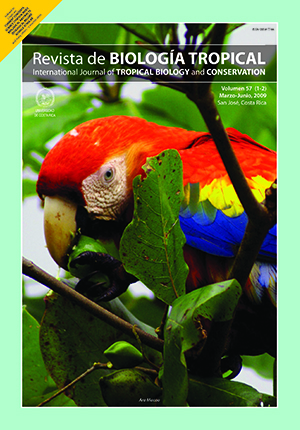Abstract
The Menidia humboldtiana silverside is considered one of the most important species in fisheries in some states of Mexico. Knowing the choice that this species exercises over its food gives us an understanding of the behavior of zooplankton in presence of zooplanktonic fish, and tells us if the silverside choose amongst bigger prey fish, and if there is competition for food between the native and introduced fish in the reservoir. The purpose of this study was to determine if M. humboldtiana selects its food, and in which genera, and to establish whether there was an overlap in the diet of the different sizes of silverside. The fish were catched with a 88 mm mesh net, in six sampling points during one year, from Danxhó (19°5 ́17” – 53 ́46” N, 99° 32 ́42” – 35 ́40” W) reservoir. Samples of filtered zooplankton were also taken with a 125 micron net. The analysis of stomach contents was carried out in fish grouped by regular size intervals during each season of the year, using the volumetric method and Chesson’s selectivity coefficient. To evaluate the trophic overlap between the different size groups, the Morisita index, modified by Horn, was used. The zooplankton community was represented by twelve genera: Mastigodiaptomus and Cyclops (Copepoda); Bosmina, Diaphanosoma, Daphnia, Ceriodaphnia, Moina, Alonopsis and Camptocercus, (Cladocera); Asplanchna, Conochillus and Filinia (Rotifera). Mastigodiaptomus was the most abundant throughout the year. The silverside consumed only four genera: Bosmina, Mastigodiaptomus, Daphnia and Ceriodaphnia; the group measuring 5 to 8.9 cm consumed a high percentage of Bosmina, Mastigodiaptomus and Daphnia, and a lesser percentage of Ceriodaphnia. The larger fish (9 to 10.9 cm) consumed only Mastigodiaptomus and Daphnia. In accordance with the selectivity values, the small and medium size silverside selected their prey, with more intensity on the genera Bosmina and Daphnia, while the bigger fish concentrated on Daphnia and Mastigodiaptomus. During spring, the silverside between 3 to 8.9 cm showed overlap in diet; in summer the bigger size group (7-10.9 cm) showed the overlap. In autumm the overlap ocurred in all sizes, and in winter it was shown only in the medium size fish (5-8.9 cm).Comments

This work is licensed under a Creative Commons Attribution 4.0 International License.
Copyright (c) 2009 Revista de Biología Tropical
Downloads
Download data is not yet available.






